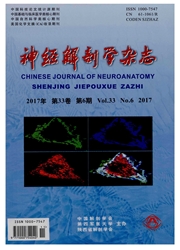

 中文摘要:
中文摘要:
目的:建立体外培养和诱导嗅黏膜神经干细胞向酪氨酸羟化酶阳性神经元分化的方法,探讨该细胞的干性和分化特性。方法:首先用含10%胎牛血清的DMEM/F-12混合培养基培养成年大鼠嗅黏膜细胞,当细胞贴壁后将培养基更换为含表皮生长因子(epidermal growth factor,EGF)和碱性成纤维细胞生长因子(basic fibroblastgrowth factor,bFGF),不含血清的干细胞培养基,以促进干细胞增殖形成神经球。将神经球取出用干细胞培养基悬浮培养以纯化扩增神经干细胞。应用干细胞相关蛋白Nestin及CD133的抗体对神经干细胞进行免疫荧光染色,观察上述蛋白在细胞的表达。用Neurobasal培养基(含B27、NGF、ATRA及SHH)培养扩增后的神经干细胞,诱导其向神经元分化。用神经丝蛋白(neurofilament-200,NF-200)和酪氨酸羟化酶(tyrosine hydroxylase,TH)抗体对分化的细胞进行免疫荧光染色;用免疫印迹法检测上述细胞裂解样品内的相应标志蛋白的电泳条带。结果:嗅黏膜神经干细胞高表达Nestin及CD133两种神经干细胞标志蛋白;干细胞经诱导分化后其形态具有神经元特征,并且高表达NF和TH两种神经细胞标志蛋白。结论:贴壁/悬浮序贯培养方法可体外纯化扩增嗅黏膜神经干细胞,该细胞可分化为酪氨酸羟化酶阳性神经元。
 英文摘要:
英文摘要:
Objective: To explore the biological characteristics and stemness of the neural stem cells derived from nasal olfactory mucosa, the methods of culturing and inducing differentiation of the stem cells to tyrosine hydroxylase positive neurons were established. Methods: The cells harvested from olfactory mucosa of adult rats were adherent cultured with DF12 medium contained 10% FBS followed by the serum-free medium containing basic fibroblast growth factor (bFGF) and epidermal growth factor (EGF) to generate the neurospheres. The primary neurospheres were harvested and cultured in suspension with serum-free medium containing bFGF and EGF, then passaged to generate secondary neurospheres under the free-floating condition. The purified neural stem cells were induced to differentiate to tyrosine hydroxylase positive neurons with the Neurobasal medium supplemented with B27, sonic hedgehog (SHH), all-trans-retinoic acid (ATRA) and nerve growth factor (NGF). The neural stem cells and induced neurons were identified with the antibodies against markers of neural stem cells, nestin and CD133, and markers of neurons, neurofilament-200 (NF-200) and tyrosine hydroxylase (TH) by immunofluorescence respectively. The proteins of nestin, CD133, NF-200 and TH were tested by Western blotting. Results: The neural stem cells from nasal olfactory mucosa express CD133 and nestin. The stem cells could be induced to differentiate to cells with morphologic characteristics of neuron. The induced neurons could express NF-200 and TH. Conclusion: The neural stem cells from nasal olfactory mucosa could proliferate and be purified by adherent/suspension culture with definite medium. The neural stem cells could be induced to differentiate to TH- positive neurons.
 同期刊论文项目
同期刊论文项目
 同项目期刊论文
同项目期刊论文
 期刊信息
期刊信息
